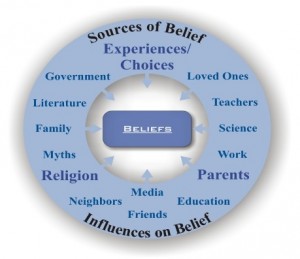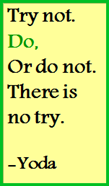As I mentioned last time in the first of this three-part series on taking action, getting clear and accurate about what you want to achieve is critical and will only get you about 25% of the way along the path to success (if you missed Part 1 click here). The rest of the path involves actually doing what you have set out to do. This sounds easy enough, but we inevitably encounter barriers that stand between us and what lies ahead. In Part 2, you will discover how to recognize and overcome your limiting beliefs and bring yourself closer to attaining what you want from life.
Part 2: Recognize and overcome your limiting beliefs
Over many years of coaching individuals in small and mid-sized companies, I discovered that many people are held back by a limiting belief system. These clients know clearly what it is they want to create, they have verified that it is the right action to take, but their internal belief system speaks up and says “You can’t do that!” The voice of the limiting belief system is very convincing. You see, it has been establishing itself in the psyche for so long – often for an entire lifetime – that we simply come to accept what it tells us without question. When the beliefs that we have about ourselves tell us that we cannot achieve our goals, it is time to shift them.
How do I know if I might have limiting beliefs?
The easiest way to determine whether you might have limiting beliefs is to simply take a look at the results you are getting for your efforts. If you have made multiple attempts to achieve a goal and the results aren’t what you want, it’s time to look for a limiting belief that could be holding you back.
 Where do limiting beliefs come from?
Where do limiting beliefs come from?
To recognize your own limiting beliefs (yes, most of us have at least a few) it is helpful to understand where they typically come from. I like to use the model on the right to illustrate the fact that each of us has sources of belief based on our individual life experiences and the choices we have made as a result of our experiences. We are also constantly bombarded with influences on belief just by simply living as a member of society. Key sources and influences include our parents, education, religion, and friends. Beliefs are formed from information conveyed directly to us, but they can also be formed based on our interpretations or opinions about the messages we receive.
Becoming aware of the factors that make up your own belief system is often helpful as a vehicle for reflection on what might be holding you back from taking action.
Do you recognize any possible sources of or influences on your own limiting beliefs? What beliefs could be standing between you and doing what brings you the most joy in life?
How can we stop limiting beliefs in their tracks?
If you are having difficulty taking action and you have a good indication that a limiting belief could be standing in your way, there are several things you can do to stop those beliefs in their tracks.
1. Be an observer of the observer you are.
Take a moment to reflect.
How do you observe the world?
Are your observations impartial, or are you looking at the world through the lens of your beliefs?
What messages are you sending yourself about your capabilities and competencies?
Is your belief system helping you or hindering you in taking action?
All these questions clarify the way you observe the world and the way you observe the world makes all the difference.
2. Reframe “change” as “learning” to shift from “resistance” to “choice”.
Which feels better to you: the idea of changing or the idea of learning?
Often when people are trying to take action toward reaching a goal, they frame that action in terms of what they must change. Let’s say Frank has a goal to lose 20 pounds over the next year. Frank might start to list in his mind all of the things that he must change such as his diet, activity level, routines and habits. “Whoa! That is a lot of stuff for a person to change all at once,” Frank thinks to himself. “I’ll never be able to stick with that.” The “change” mindset is often met with this type of resistance due to the fear and self-doubt that people typically feel about the idea of change.
My advice to Frank is to reframe his goal as simply a matter of learning. All of a sudden, Frank’s thoughts shift from resistance to the choices associated with learning. As a learner, Frank becomes aware that he doesn’t need to know everything in order to make progress. He can choose to move along the path of learning from beginner to master, and he can choose to give himself permission to make mistakes. Making mistakes during the process of learning is more than OK, by the way – it’s wonderful! A learner that is seasoned by mistakes made along the way will always be more successful than a person who is stuck in the resistance of change.
Change puts you at resistance. But learning puts you at choice.
3. Eliminate cognitive blindness
You don’t know what you don’t know. And there’s a good chance that what you don’t know is getting in the way of what you want to achieve.
So, keep your mind open to the reality that there is always more to learn about yourself that will help you move forward in taking action and creating a joyful life.
4. Learn to ask for help
We all need support from time to time. One of the times when we need it most is when we are having difficulty taking action. Contrary to what your limiting beliefs may tell you, asking for help is not a sign of weakness. You wouldn’t hesitate to ask for help if you were stranded on the side of the road with two flat tires.
Choose to embrace the belief that you can be strong and need help taking action on your goals.
5. Get in touch with your emotions by observing your body
The best indicator about your state of mind is how you feel in your body. Your emotions are triggered reactions that appear in your body as sensations before they appear as an outpouring of emotion. There’s a good chance that if you feel stuck on your path to a higher deserved goal you tuned your body out.
So, stay tuned into your body to sense when you feel the tension of a limiting belief creeping in to stand between you and the action you want to take.
How can we shift our limiting beliefs?
To overcome a limiting belief is to shift it to a place where we can examine it, understand it, and choose to let it go. Two resources that I highly recommend for discovering and shifting limiting beliefs are as follows.
1. Byron Katie developed a process known as “The Work”. The Byron Katie method is my “go-to” tool of choice for coaching clients in shifting limiting beliefs. It’s simple and fast. It’s powerful stuff. And it’s free. The key to the process lies in these Four Questions:
- Is it true?
- Can you absolutely know that it’s true?
- How do you react, what happens, when you believe that thought?
- Who would you be without the thought?
- Now turn the thought around to its opposite.
Read more about it and watch the videos on her website.
2. The Emotional Freedom Technique (EFT) is a tapping technique developed by Gary Craig. It involves working with the body, energy, and emotions. Learn more on the EFT website or YouTube.
Coming up next time in “Forget Visioning – Let’s Take Action, Part 3”
You’ve gotten clear and accurate about what you want to create and you understand how to recognize and overcome your limiting beliefs. In Part 3, you will learn how to get the support you need to move you further along the path to attaining what you want from life.
In the meantime, stop and reflect.
Is it possible that you have one or more limiting beliefs that are standing in your way?
What can you do to release yourself from the influence of your limiting beliefs?
Would shifting your belief system make a difference for you in taking action today?
Please share your thoughts in the comments. I would love to hear what shifted for you.


